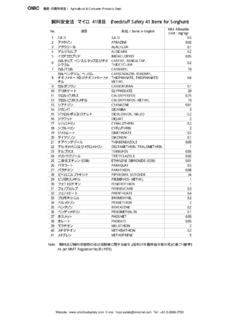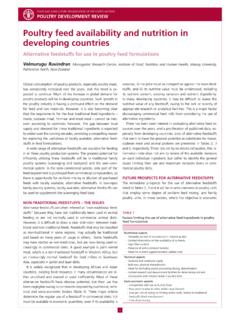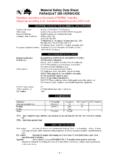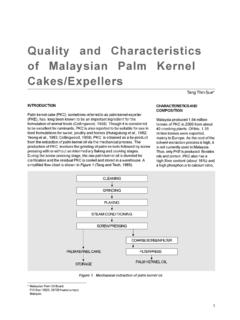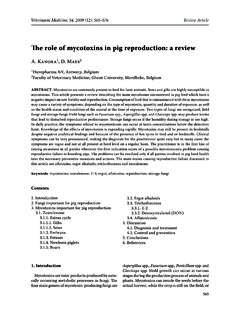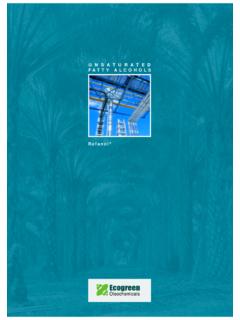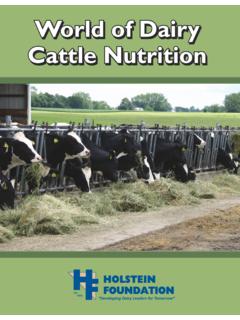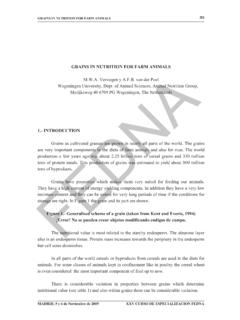Transcription of Use of Turkey Meal as a Replacement for …
1 North American Journal of Aquaculture 69:351 359, 2007 [Article]. Copyright by the American Fisheries Society 2007. DOI: Use of Turkey Meal as a Replacement for menhaden fish Meal in Practical Diets for Sunshine Bass Grown in Cages KENNETH R. THOMPSON, LINDA S. METTS, LAURA A. MUZINIC, SIDDHARTHA DASGUPTA, AND CARL D. WEBSTER*. Aquaculture Research Center, Kentucky State University, 103 Athletic Drive, Frankfort, Kentucky, 40601, USA. YOLANDA J. BRADY. Department of Fisheries and Allied Aquaculture, Auburn University, Auburn, Alabama, 36849, USA. Abstract. A 391-d feeding trial was conducted with caged juvenile (mean weight g, SD g). sunshine bass (female white bass Morone chrysops 3 male striped bass M.)
2 Saxatilis) to evaluate growth, feed conversion, protein efficiency ratio, body composition, and fillet composition resulting from diets with decreasing levels of fish meal (FM; 30, 20, 10, and 0%) and increasing levels of Turkey meal (TM; , , , and ). We stocked 100 randomly selected fish into each of 12 floating cages ( m3). Twice daily, fish were fed all they could consume in 30 min. Four practical diets were formulated to contain 40% protein and to be isoenergetic. After 391 d, significant (P ) differences were found in growth; fish fed the control diet (30% FM, 0% TM) had higher individual final weight, percent weight gain, and specific growth rate than fish fed FM and TM.
3 However, differences for those variables were not apparent between the control group and fish fed the 20% FM and TM diet or the 0% FM and TM diet. Diet composition did not significantly alter amount of diet fed, feed conversion ratio, protein efficiency ratio, percent survival, fillet yield, or hepatosomatic index among treatments. Results indicate that sunshine bass grown in cages for 391 d can be fed a diet containing 0% FM and TM without adverse effects on growth, feed conversion ratio, and body composition; more diverse diet formulations for sunshine bass and reduced usage of menhaden fish meal are therefore possible. Production of sunshine bass (female white bass dependence on marine-derived protein sources, allow Morone chrysops 3 male striped bass M.)
4 Saxatilis) is for continued expansion of the global aquaculture one of the fastest growing segments of U. S. industry by utilizing renewable ingredients, and help aquaculture and is now fifth in volume and fourth in decrease diet costs, thereby potentially increasing value (US$28 million in 2005) among all food fish profits for sunshine bass producers. grown in the USA. However, high production cost is Soybean meal (SBM) is widely known to be a cost- the greatest limitation to this industry (Carlberg et al. effective alternative for high-quality FM in diets for 2000). The continued expansion of the sunshine bass many aquaculture species because of its high protein industry depends in part on diet cost reduction, and one content, relatively well-balanced amino acid profiles, way of reducing diet costs is to decrease or eliminate reasonable price, and steady supply (Lovell 1988.
5 Marine fish meal (FM), which is the most expensive Chou et al. 2004). Lovell (1988) reported that SBM has macroingredient (.US$800 per ton) in an aquaculture one of the best amino acid profiles of any plant protein diet. With the static or declining fish populations that feedstuff. However, sunshine bass diets containing are used to produce FM, any negative disturbance, SBM as the sole protein source might be nutritionally inadequate because methionine and lysine are the most supply disruption, or availability problem can lead to limiting amino acids in high-SBM diets (Andrews and dramatic increases in the commodity price. Further, the Page 1974; Lovell 1989). Other negative factors that capture of wild fish used to feed cultured fish is may reduce growth when dietary FM is completely thought to be unsustainable by many critics of replaced by SBM are decreased digestibility of aquaculture.
6 One approach to reducing FM in sunshine nutrients and reduced palatability if SBM is used at bass diets is to replace it with alternative animal or high percentages. It has been reported that the activity plant protein ingredients, which will alleviate the of protease (trypsin) inhibitors in crude or inadequately heated SBM may be a reason for reduced growth * Corresponding author: (Dabrowski and Kozak 1979; Wilson and Poe 1985). Received January 23, 2007; accepted March 16, 2007 However, Webster et al. (1992c) stated that this may Published online September 13, 2007 not be of practical importance because commercially 351. 352 THOMPSON ET AL. TABLE 1. Amino acid composition (%) and proximate processing methods or quality (Webster et al.)
7 2000). composition (%) of Turkey meal (Conagra, Omaha, Nebraska) Muzinic et al. (2006) reported that Turkey meal (TM), a and poultry by-product meal (PBM; feed grade [FG] and by-product of the Turkey industry, may be an important petfood grade [PFG]). ingredient for FM Replacement in aquaculture diets Component Turkey meal PBM-FG PBM-PFG because of its high protein content, balanced amino Amino acids a acid profiles (Table 1), and lower cost (when available). Alanine than FM. However, little published data are available Arginine on the use of TM in aquaculture diets and only one Aspartic acid Cystine published report describes its use in sunshine bass diets Glutamic acid (Muzinic et al.
8 2006). Glycine Sunshine bass can be grown in a variety of culture Histidine Isoleucine systems, including ponds, tanks, or cages. Although Leucine cage culture represents a small percentage (,5%) of Lysine the total sunshine bass production, it is an Methionine Phenylalanine intensive production method that allows for growing Proline of fish in ponds that may otherwise be difficult to Serine Threonine harvest, either due to irregularly shaped pond bottoms, Tyrosine shoreline contour, or presence of debris and obstacles. Valine Previous cage research reported acceptable growth Proximate analysis (dry-matter basis)a rates and high (.85%) survival of sunshine bass Moisture (Webster et al.
9 1995c, 1997a, 2001). Protein Lipid Cages have several advantages over open-pond Fiber culture systems for growing sunshine bass: low initial Ash investment, reduced labor, and more efficient use of a Amino acid composition and proximate analysis of Turkey meal were existing pond space. However, use of cages reduces the determined by a commercial analytical laboratory (Eurofins Scientific, availability of natural foods and may alter nutritional Inc., Des Moines, Iowa). specifications of the diet (Lovell 1973). Reduction or elimination of FM in diets fed to cage-grown sunshine available SBM usually has little trypsin inhibitor bass could adversely affect growth. Webster et al.
10 Activity if adequately processed. Likewise, SBM is (1997a) reported that cage-grown palmetto bass (male deficient in available phosphorus; although SBM white bass 3 female striped bass) could be fed diets contains approximately phosphorus, only about with 15 45% FM, but those fed a diet containing SBM. one-third to one-half is biologically usable by fish and meat-and-bone meal but no FM had reduced (Lovell 1988). Thus, inclusion of an animal protein growth. source, combined with SBM, may assist in the In a recent 2006 survey, small (350 450-g) sunshine formulation of diets involving total Replacement of bass were presented to chefs in Kentucky; many chefs liked the smaller fish , particularly whole-dressed fish , FM.


